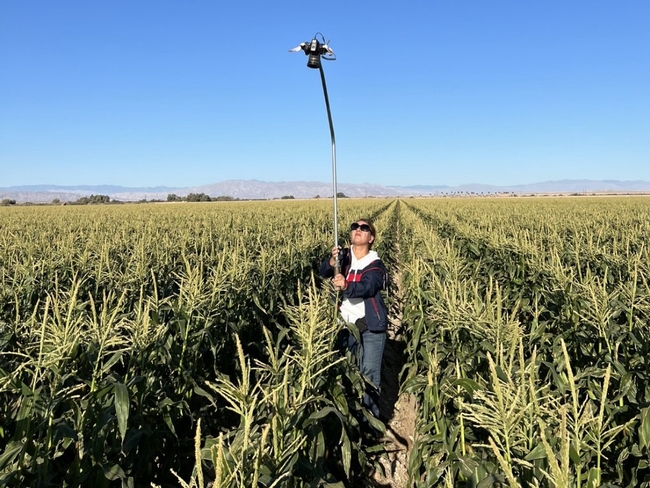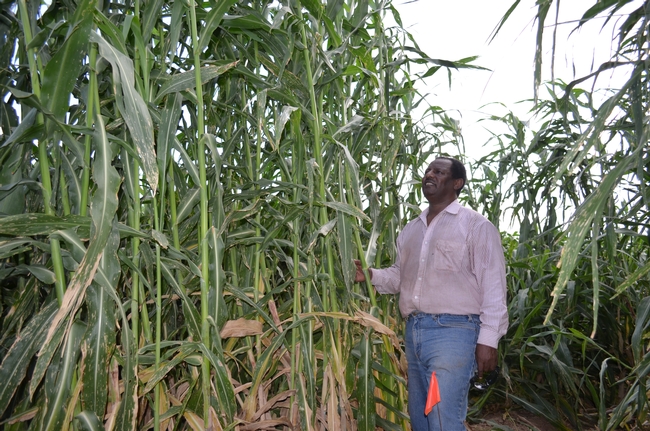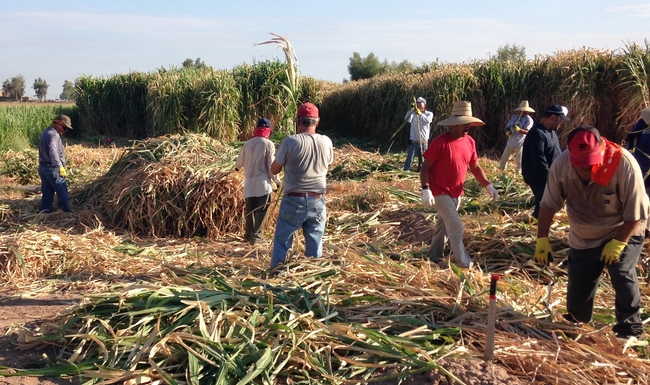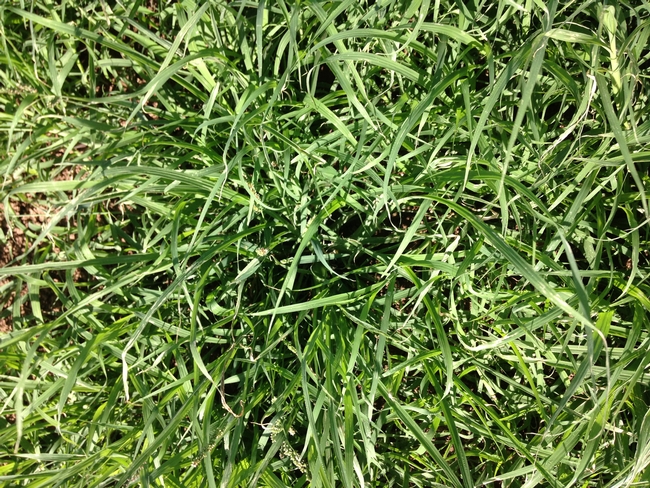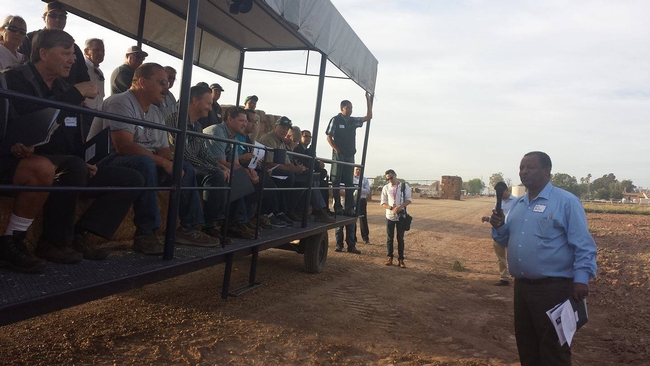Posts Tagged: Imperial County
Drip-irrigation study sees ‘huge’ reduction in water, fertilizer use for sweet corn
Study by UCCE advisor in Imperial County also shows 5% increase in yield
A new study suggests that drip irrigation for sweet corn can significantly conserve water, reduce fertilizer use and boost crop yield in the low desert of California – and likely in other areas of California with similar conditions.
Although Imperial County is California's top sweet corn-producing county, with about 8,000 acres planted on average each year, irrigation methods for this crop have been rarely studied in this region (or anywhere else in the state), according to Ali Montazar, UC Cooperative Extension irrigation and water management advisor for Imperial, Riverside and San Diego counties.
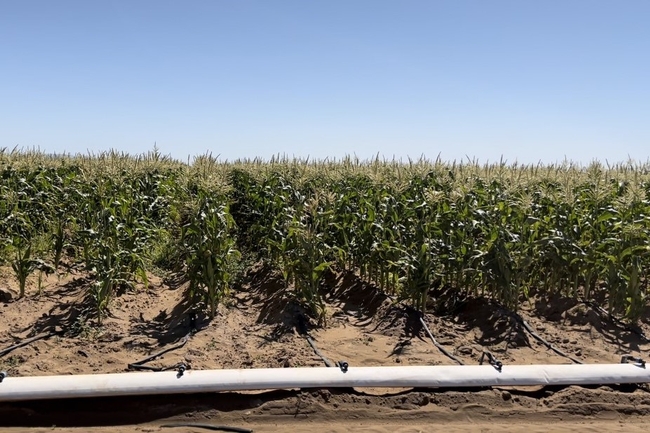
Montazar conducted a study in the Imperial Valley over two crop seasons, 2020-21 and 2021-22, to demonstrate and quantify the potential benefits of switching to drip irrigation from the more common furrow irrigation method. The study, available in a recent issue of UC Agriculture and Natural Resources' Agricultural Briefs, will be published in a future issue of Vegetables West.
“I'm hoping with this project we can encourage growers to adopt it, because it seems very promising,” said Montazar, noting that drip irrigation is a “new practice” for sweet corn in California.
Among the 11 commercial sweet corn fields in the study over the 2021-22 season, the six that were under drip irrigation used, on average, 37% less water than the five under furrow irrigation. In absolute terms, the drip-irrigated fields saw an average water savings of 2.2 acre-feet per acre; for Montazar, who has studied drip for a variety of crops in the Imperial Valley, that was an astonishing result.
“I've worked with drip on processed onions, lettuce, alfalfa, spinach … we've never seen a figure like 2.2 acre-feet per acre, that's huge,” he said, attributing the dramatic drop-off to the high volume of water required to furrow-irrigate the sandy soil in the Imperial Valley.
More efficient irrigation also means less fertilizer is needed – a boon to the environment and Salton Sea water quality, as well as growers' bottom line. With fertilizer prices continuing to rise, sweet corn growers using drip could see a substantial 25% cost savings on fertilizer expenses – about $150 per acre less – compared to furrow irrigation, according to Montazar's study.
And by relieving plants of the stress from over- and under-irrigated conditions, drip irrigation helps keep soil moisture at its “sweet spot” – resulting in a 5% increase in marketable crop yield for sweet corn in the study.
“When we have a better, more efficient irrigation system, we can maintain soil moisture at a desired level, over time and space,” Montazar explained.
Because the benefits of drip appear to be linked to soil conditions (sandy loam, and other light soils), Montazar believes that this irrigation practice could deliver relatively similar water and fertilizer savings and improved crop yield in other regions across California, regardless of climactic differences.
“If you use drip in any part of the state, you have the benefits of drip – more uniform water application, more uniform fertilizer – that's not related to the desert,” he said. “That's part of the system's potential.”
Montazar plans to follow up on his preliminary study with additional research on sweet corn and drip irrigation during the 2022-23 crop season.
New research fills gap on best practices for California carrot production
One doesn't need to be a seasoned farmer to know that growing conditions in Canada are completely different than those found in the low desert of California.
And yet, for many years, studies conducted in Canada were used to generate nitrogen uptake data for the California carrot production system, so growers managed their fields based on their own experiences – and that research conducted thousands of miles to the north.
Carrots had been among the crops grown in California that did not have site-specific data to suggest the best source, rate, timing and placement of nitrogen, in the highly variable cropping seasons and locations throughout the state. That's why new information – based on local research and published in August – is invaluable to farmers in Imperial and Kern counties, where the majority of the carrots in California are grown.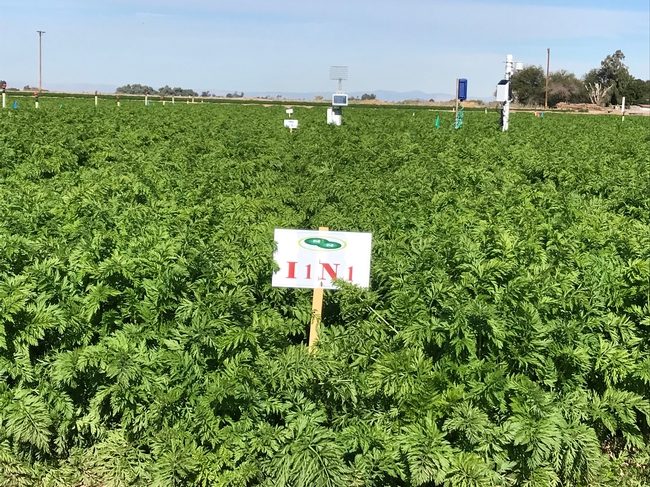
Two years of data from two experimental trials at UC Agriculture and Natural Resource's Desert Research and Extension Center – as well as from 10 commercial fields – produced key recommendations for farmers to make the most of their irrigation and nitrogen applications.
“The point is we developed information in your field, based on your practices, your climate, your production system – and this is what is really happening,” said Ali Montazar, UC Cooperative Extension irrigation and water management advisor for Imperial County. Montazar conducted the study alongside Daniel Geisseler, UCCE nutrient management specialist at UC Davis, and Michael Cahn, UCCE irrigation and water resources advisor for Monterey County.
With reliable data gathered under real-world conditions, Montazar said growers now have solid reference points for when – and at what rate – to irrigate and apply fertilizers in the low desert environment. One of the key findings, for example, was that the carrots' nitrogen uptake is generally low in the first 40 to 50 days, so growers are advised to limit their fertilizer application during that period.
Then, by tailoring those basic guidelines to their own site-specific situation and optimizing their practices, growers can maximize the amount of nitrogen taken up by the carrots – and minimize the amount that is leached out.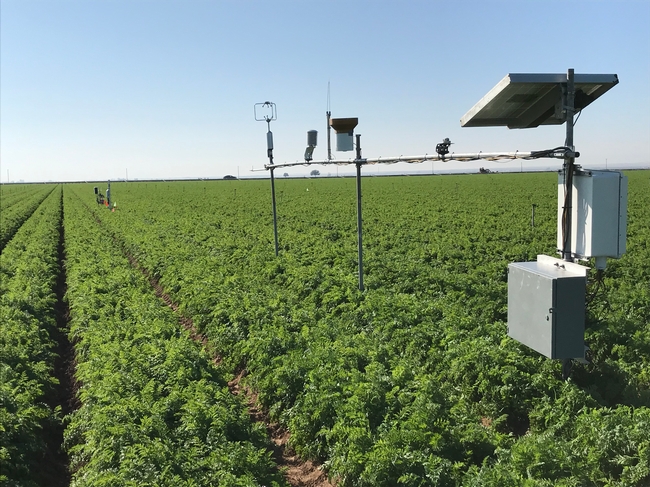
“Improving irrigation and nutrient management in the desert production system is what local growers are themselves trying to achieve. With improving efficiency and reducing nutrient leaching, we can improve the quality of water in the Salton Sea,” said Montazar, noting the longstanding challenges of reducing contaminants from irrigated lands to protect its unique ecosystem and wildlife.
While contamination of groundwater is not a critical issue in the desert, the best practices in this study can also help carrot growers in parts of California where nitrogen leaching into groundwater and drinking water supplies is a greater concern.
Montazar is currently leading a team in studying carrot-growing management practices under slightly different conditions in Kern County, with the hopes of publishing findings in late summer 2022.
The Imperial County study, “Spatial Variability of Nitrogen Uptake and Net Removal and Actual Evapotranspiration in the California Desert Carrot Production System,” is published in the journal Agriculture, and can be found at https://doi.org/10.3390/agriculture11080752. Findings and recommendations also appear in Progressive Crop Consultant: https://progressivecrop.com/2021/09/new-knowledge-based-information-developed-to-enhance-water-and-nitrogen-use-efficiency-in-desert-fresh-market-carrots/.
Funding for this study was provided by the California Department of Food and Agriculture's Fertilizer Research and Education Program, as well as the California Fresh Carrots Advisory Board.
Former goat herder’s crop research promotes prosperity for Imperial Valley farmers
Oli Bachie, “person of the globe,” researches new desert crops to spur economic growth
While herding goats along dusty roads as a boy growing up in Oromia, Ethiopia, Oli Bachie began striving to improve his economic position in life. His path to a better life passed through the Philippines and Canada before reaching the United States. Now, carrying the mantle of Ph.D., the UC Cooperative Extension farm advisor is doing research to help California farmers take advantage of new opportunities for economic growth.
More than 400 different crops and animals are commercially produced in California. The wide array of agricultural products keep California farmers competitive in the global market. UC Cooperative Extension research into new crops provides growers with information that can lower the risk of trying something new.
Rhodes grass, giant king grass, quinoa and teff are among the crops Bachie has been studying since he joined UC Agriculture and Natural Resources in 2012.
“Giant king grass and Rhodes grass were brought to my attention by companies who wanted me to test their adaptability, biomass yield and nutrition as livestock feed,” Bachie said. “My findings proved that they indeed adapt and produce high biomass and were nutritionally competent or better than many of the low desert grown grass forage crops.”
Two companies provided Bachie with funding to conduct the research. “We do research for industries, companies and growers as long as they provide funding and if we believe that the outcome of the research benefits our clientele and the local economy,” he explained.
Viaspace, a company that grows giant king grass in 11 locations in eight countries on four continents, has relied on Bachie's research for establishing its plantings in the Imperial Valley.
“Oli's research helped us establish basic growing procedures and parameters for Imperial County. It provided the critical information that gave us the confidence to start a larger commercial effort in the desert,” said Haris Basit, vice chairman of Viaspace.
To share information with Imperial Valley growers, Bachie has presented his research results on Rhodes grass varieties at field days and workshops and published in the UCCE Imperial AgBrief newsletter and in the proceedings of the 2019 Western Alfalfa and Forage Crops Symposium. During the COVID-19 pandemic, he has been giving talks via Zoom on Rhodes grass as a new emerging crop, including a zoom workshop organized by the University of Arizona.
“Rhodes grass productivity is well-recognized and is adapted for production not only in the Imperial Valley, but also as far as San Joaquin County and in the state of Arizona,” he said. “A grower in Imperial has started to export Rhodes grass hay to the Middle East. More and more growers within the Imperial Valley and beyond are interested in growing Rhodes grass. I get lots of calls to answer Rhodes grass-related questions. There is now a Rhodes grass seed distributing company in Imperial Valley.”
Giant king grass – a hybrid of elephantgrass and Napier grass, which both grow well as wild plants in Ethiopia – and Rhodes grass are widely grown in Ethiopia. But Bachie didn't study these grasses until he joined UC Cooperative Extension.
Bachie grew up farming with his parents in the rural western part of Oromia, where most coffee and food crops are produced in Ethiopia. “By the way, the name ‘coffee' is derived from a place in Oromia called Kaffaa,” he noted.
“After school in winter, when most farming takes place, I engaged myself in farming,” Bachie said. That afterschool activity piqued his interest in farming and fueled his pursuit of a bachelor's degree in plant sciences from Haromaya University in Ethiopia.
“At that time, when I joined the university, there was only one university in the country,” he said. “I was lucky enough to be one of the few to get university admissions among thousands of high school students.”
In Ethiopia, he worked on a program sponsored by the Ministry of Agriculture and United Nations Food and Agriculture Organization for six years, mostly as a crop protection expert. He studied insects, weeds, pathogens and other crop pests on field crops, vegetables and horticultural crops.
“The experiences I gathered from Ethiopia help me provide services in Imperial County in multidisciplinary pest management – insects, pathogens, weeds and nematodes – at times when we did not have any pest management advisor in Imperial County,” he said. “It has also given me the opportunity to deal with clientele with easy transfer of scientific knowledge.”
Bachie was selected as an FAO fellow to pursue a master's degree in agronomy at the University of the Philippines.
“My area of particular concern then was to look at allelopathy (a chemical inhibition of plant extracts or exudates) as a potential inhibition of weed growth,” Bachie said. His plans to develop a biological weed management approach were disrupted when he graduated with a master's degree and he refused to return to his dictator-led home country.
“Ethiopia was then and is still ruled under a brutal government where educated personnel have little value,” he explained. After graduation, he sought settlement in another country. “That supportive state, which I thank dearly, was Canada.”
After earning a master's degree in forestry from the University of Toronto, Bachie accepted a job at a university teaching network administration and came to the U.S., where he earned a Ph.D. in biological sciences at UC Riverside, “Americanizing not only myself, but also my credential and now I serve UC with full interest and strength,” said Bachie, who holds dual U.S. and Canadian citizenship.
In the spring of 2019, Bachie started comparing grass forage crops (bermudagrass, kleingrass, Rhodes grass and teff) with moringa for livestock feed under low desert conditions. Growers will be able to use the research results to decide which crops will be most profitable for their own operations.
Last summer, Bachie completed a variety trial of quinoa, a grain grown primarily for its edible seeds. He tested the adaptability and grain yield of 35 varieties of quinoa in the heat and biotic stress of the Imperial Valley.
“Of the tested varieties, many tolerated the high heat of the desert and gave promising yields,” said Bachie, who showed the varieties to farmers at an agronomy and irrigation crops field day. “The high grain prices of quinoa in the U.S. and the proof of adaptability and yielding capacity under the low desert condition is expected to attract some growers to grow some quinoa varieties in the Imperial Valley.”
Bachie recently completed a survey of weeds in the county and is planning to publish a handbook titled “Weeds of Imperial County and Management Approaches.”
“While my journey is a huge zigzag and I came up through difficulties, I am very glad that I was able to travel and survive and made myself from a goat herder to an American Ph.D.,” said Bachie, who has also taught biology and environmental science courses part time at Victor Valley and Imperial Valley community colleges, respectively.
“My travel all over the world has enhanced my concepts of human diversity and the affinity to associate and work with people of various backgrounds. To be sure, I call myself a person of the globe.”
